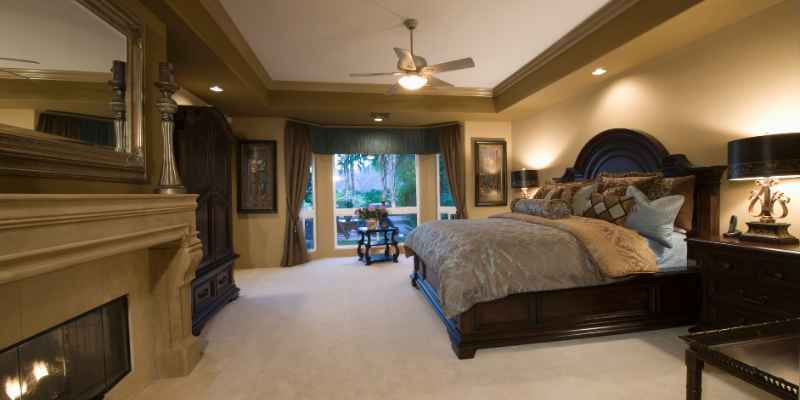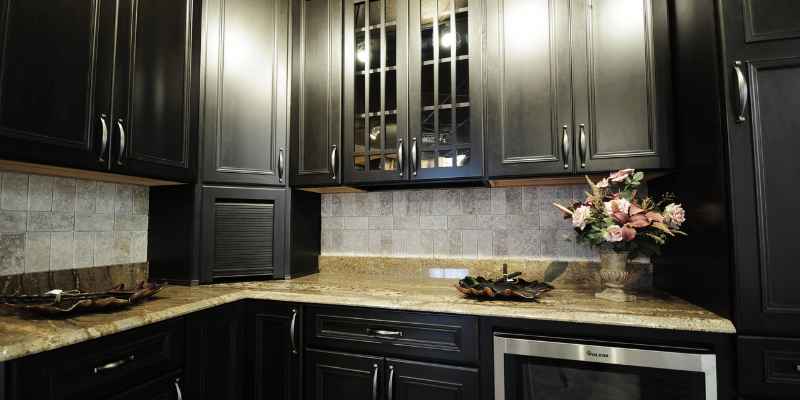Dark wood furniture pairs well with neutral colors such as white, beige, gray, or earthy tones. These color options complement the rich, warm tones of the dark wood, creating a harmonious and elegant look for any space.
Additionally, these neutral colors provide a versatile backdrop that allows you to easily change the overall aesthetic by incorporating different accent colors or textures. Whether you prefer a classic, modern, or eclectic style, these neutral color choices will help enhance the beauty and sophistication of your dark wood furniture.
Choosing The Right Color Scheme
Choosing the right color scheme for your dark wood furniture can transform your space and enhance its overall aesthetic appeal. When it comes to coordinating colors with dark wood furniture, the options are abundant. Consider the existing decor, explore warm and cool tones, and let your personal preferences guide you towards finding the perfect color scheme. Let’s delve into each aspect in detail.
Consider The Existing Decor
When choosing a color scheme for your dark wood furniture, it is crucial to consider the existing decor of the space. Take into account the style, theme, and overall ambiance of the room. Are you aiming for a modern, minimalist look, or do you prefer a traditional, vintage feel? Assessing the existing colors in the room will help you determine which color scheme is ideal.
If the room already has a vibrant color palette, you might want to opt for neutral tones that can complement the dark wood furniture without overpowering the space. On the other hand, if the room lacks color, you have the freedom to create a bold, eye-catching contrast.
Exploring Warm And Cool Tones
Warm and cool tones play a vital role in determining the mood and atmosphere of a room. Warm tones, such as shades of red, orange, and yellow, can create a cozy and inviting vibe. They harmonize well with dark wood furniture, adding warmth and depth to the space.
In contrast, cool tones like blues, greens, and greys can evoke a sense of tranquility and serenity. They work well in spaces where you want to create a calming ambiance. Cool tones can also provide a striking contrast against dark wood furniture, making it the focal point of the room.
Ultimately, the choice between warm and cool tones depends on the atmosphere you want to create in the space. Experiment with different color combinations to find the perfect balance that suits your taste.
Remember, it’s not just about the wall color! Consider the hues of your curtains, rugs, and accessories to ensure a cohesive color scheme throughout the room.
Now that you have a better understanding of different color schemes and how they can enhance the beauty of your dark wood furniture, it’s time to start brainstorming. Take inspiration from various sources, such as home decor magazines, online platforms, or even nature. Trust your instincts and have fun exploring different possibilities until you find the perfect color scheme that brings life and harmony to your space.

Contrasting And Complementing Colors
When it comes to decorating with dark wood furniture, choosing the right colors is essential. The right colors can either enhance the richness of the wood or create a striking contrast, depending on your desired aesthetic. In this article, we will explore two ways to create a cohesive and visually appealing color scheme: by utilizing neutrals to create contrast and by using analogous colors to find harmony.
Creating Contrast With Neutrals
Neutrals are a versatile option when it comes to pairing with dark wood furniture. These colors, which include shades of white, gray, and black, can create a strong contrast that highlights the richness of the wood. By incorporating neutrals into your color scheme, you can create a visually striking and balanced space.
Here are some ways to incorporate neutrals:
- Pairing dark wood furniture with a crisp white or ivory wall can create a clean and modern look.
- Using shades of gray, such as charcoal or slate, can add depth and sophistication to a room.
- Incorporating black accents, such as frames or decorative objects, can create a bold and dramatic contrast against dark wood furniture.
Remember, when utilizing neutrals, it’s important to vary the tones and textures within the color scheme. This will prevent the space from looking flat or monotonous. Adding texture through different materials, such as a plush rug or a woven basket, can also enhance the overall look and feel of the room.
Finding Harmony With Analogous Colors
Analogous colors are those that sit next to each other on the color wheel. This color scheme creates a sense of harmony and cohesion, making it a great option for those who prefer a more coordinated look. When pairing analogous colors with dark wood furniture, it’s important to choose shades that complement and enhance the wood’s natural tones.
Here are some examples of analogous color combinations:
| Analogous Colors | Example |
|---|---|
| Blue, Blue-Green, Green | Pairing a dark wood bed frame with a blue-green accent wall and green accessories can create a serene and calming atmosphere. |
| Red, Orange, Yellow | Pairing a dark wood dining table with walls painted in shades of red and accessorizing with orange and yellow accents can create a warm and inviting space. |
When choosing analogous colors, make sure to consider the undertones of the wood. For warm-toned woods, such as cherry or mahogany, opt for colors with warm undertones. For cool-toned woods, such as walnut or ash, choose colors with cool undertones. This will ensure that the colors harmonize with the wood rather than clash.
In conclusion, when it comes to pairing colors with dark wood furniture, you have two main options: creating contrast with neutrals or finding harmony with analogous colors. Whether you prefer a bold and striking look or a coordinated and harmonious one, these color schemes can help you achieve the desired aesthetic in your space.
Incorporating Textures And Patterns
When it comes to incorporating textures and patterns in a space with dark wood furniture, the goal is to create a harmonious and visually engaging environment. Mixing different textures and utilizing patterns strategically can add depth and interest to the overall aesthetic while complementing the richness of the dark wood. Let’s explore how to effectively incorporate textures and patterns to enhance the beauty of your dark wood furniture.
Mixing Textures For Visual Interest
Mixing various textures can elevate the appeal of dark wood furniture. Start by layering different textures such as smooth fabrics, rough materials, and shiny finishes to create contrast and visual interest. For instance, pairing a plush velvet sofa with a rustic wood coffee table can create a captivating juxtaposition of textures, adding depth and dimension to the room.
Using Patterns To Add Depth
When it comes to incorporating patterns, consider using them strategically to add depth to the space. Geometric patterns or stripes can work well with dark wood furniture, adding a contemporary and visually appealing element. Additionally, incorporating floral patterns or abstract designs through throw pillows, area rugs, or wall art can infuse the space with personality and charm without overwhelming the dark wood furniture.
Accessorizing With Accent Colors
When it comes to accessorizing with accent colors for your dark wood furniture, the possibilities are endless. Selecting pops of color can add a vibrant touch to your space, while balancing bold and subtle accents creates an overall cohesive look. Let’s explore some creative ideas for incorporating accent colors that will perfectly complement your dark wood furniture.
Selecting Pops Of Color:
Adding pops of color to your space can make a bold statement and bring life to your dark wood furniture. Consider these ideas:
- Choose a vibrant accent color, such as red or yellow, to create a striking contrast against the dark wood.
- Use throw pillows in bright shades to add a pop of color to a sofa or chair.
- Hang colorful artwork or tapestries on the walls to create a focal point in the room.
- Place a colorful area rug on the floor to define the space and add visual interest.
- Accessorize with vibrant curtains or window treatments to bring color to your windows.
Balancing Bold And Subtle Accents:
Achieving a well-balanced look involves incorporating both bold and subtle accents. Consider these tips:
- Opt for neutral accent colors, such as gray or beige, to create a more sophisticated and timeless look.
- Mix and match different textures and patterns in your accessories to add visual interest.
- Use metallic accents like gold or silver to add a touch of glamour to your space.
- Incorporate natural elements, such as plants or flowers, to bring a fresh and organic feel to the room.
- Consider using accent furniture pieces in complementary colors, such as a colorful armchair or ottoman.
By selecting the right pops of color and balancing bold and subtle accents, you can elevate the look of your dark wood furniture and create a space that is both stylish and inviting.
Working With Different Room Styles
When it comes to incorporating dark wood furniture into your home, it’s important to consider the style of the room. Whether you have a modern interior or a traditional setting, finding the right color combination can elevate the overall aesthetic. In this blog post, we will explore how dark wood furniture can adapt to different room styles, focusing on both modern interiors and traditional settings. Let’s dive in!
Adapting To Modern Interiors
In modern interiors, the use of dark wood furniture can create a sleek and sophisticated look. To complement the dark wood tones, consider using a color palette that incorporates neutrals such as whites, grays, and blacks. This creates a contrast that allows the furniture to stand out. Additionally, using bright and bold accent colors in small doses can add a pop of personality to the space.
Here are a few color combinations to consider:
| Color Combination | Effect |
|---|---|
| White and Dark Wood | Create a clean and contemporary aesthetic |
| Gray and Dark Wood | Establish a sophisticated and modern vibe |
| Black and Dark Wood | Add a dramatic and bold touch |
Blending Into Traditional Settings
For those with traditional settings, dark wood furniture can enhance the timeless and elegant atmosphere. When combining with dark wood tones, opt for warm and earthy colors such as deep reds, rich browns, and golden yellows. These colors complement the wood’s natural warmth and bring out its classic appeal.
Consider the following color combinations:
- Deep Red and Dark Wood: Embrace a traditional and cozy ambiance.
- Rich Brown and Dark Wood: Create a warm and inviting space.
- Golden Yellow and Dark Wood: Add a touch of brightness and elegance.
With these color combinations, you can seamlessly blend dark wood furniture into your traditional interior, adding character and depth to the overall look and feel of the space.
Remember, when working with different room styles, finding the right color combination is key to achieving a cohesive and visually pleasing design. Whether you’re aiming for a modern or traditional aesthetic, understanding how colors complement and contrast with dark wood furniture can transform your space into a stunning masterpiece.

Frequently Asked Questions On What Color Goes With Dark Wood Furniture
What Colours Go Best With Dark Wood Furniture?
Opt for neutral tones like beige, cream or gray to complement dark wood furniture. Bold colors such as navy, emerald, or burgundy also create a striking contrast. Additionally, earthy hues like olive green and terracotta can enhance the richness of dark wood furniture.
How Do You Match Dark Wood Furniture?
To match dark wood furniture, consider using neutral colors like beige or cream for wall paint and flooring. Add pops of color with accessories like pillows, rugs, or curtains. Mix in other natural materials like leather or metal to create a balanced look.
What Color Comforter Goes With Dark Wood Furniture?
A light or neutral colored comforter, such as white, beige, or pastel shades, would complement dark wood furniture well. These colors create a balanced and harmonious look in your bedroom.
What Materials Go Well With Dark Wood?
You can pair dark wood with materials like brass, leather, and natural fabrics for a rich and elegant look. These materials create a warm and inviting atmosphere and complement the deep tones of dark wood furniture.
Conclusion
Coordinating colors with dark wood furniture can greatly enhance the overall aesthetic of your space. By considering complementary, contrasting, or neutral tones, you can create a cohesive and appealing look. Remember to take into account the room’s lighting and style when making color choices.
Embracing harmonious combinations will help to bring out the best in your dark wood furniture and elevate the design of your home.


